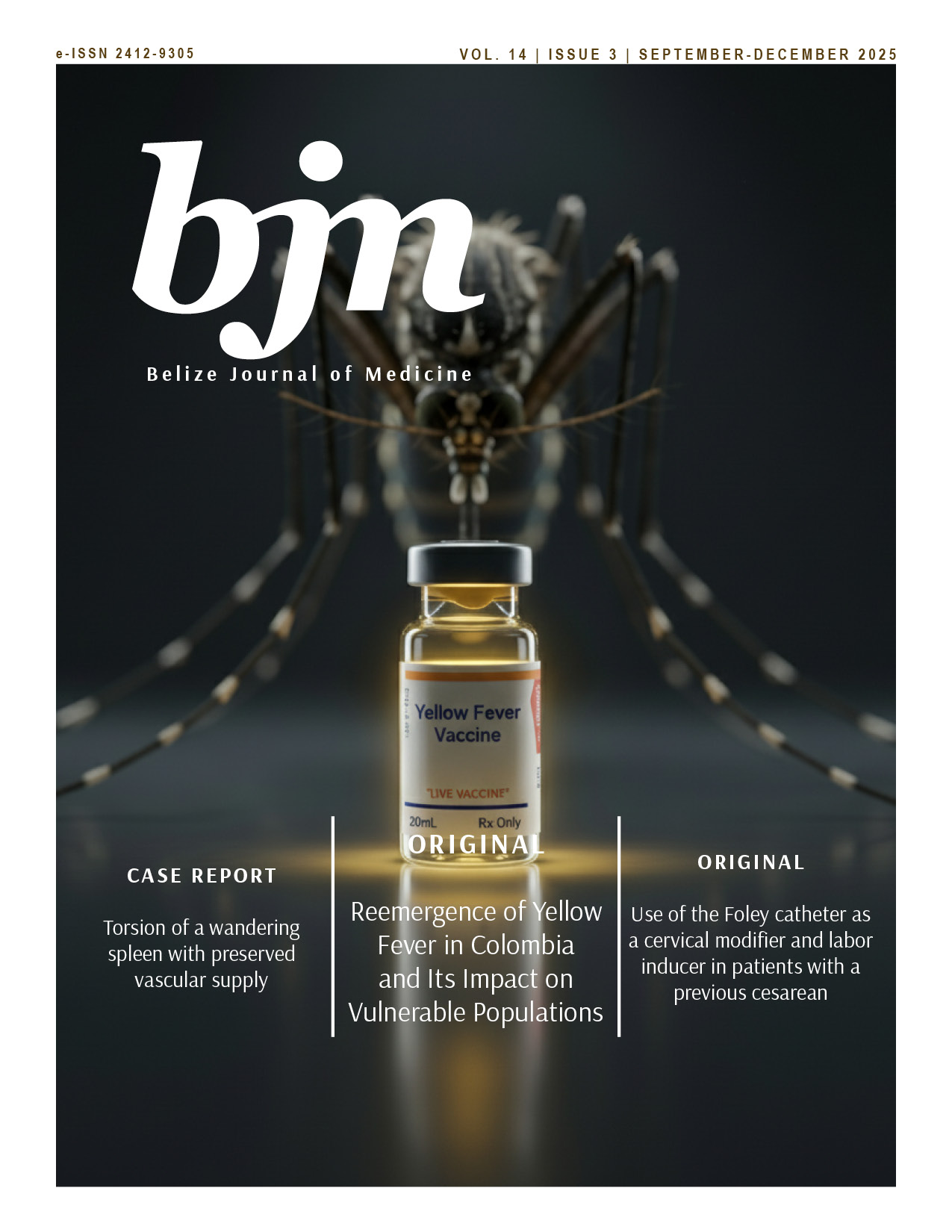Use of the Foley catheter as a cervical modifier and labor inducer in patients with a previous cesarean section
DOI:
https://doi.org/10.61997/bjm.v14i3.488Keywords:
Endocervical balloon, Foley catheter, Cervical ripener, Labor inductionAbstract
Introduction: Pregnancy and childbirth care practices vary widely between countries. The Foley balloon catheter has been used as an effective tool for cervical ripening and labour induction. Objective: To describe the results of using the Foley balloon catheter as a cervical ripener and labour inducer in patients with previous caesarean sections in a maternity hospital in Djibouti. Methods: A descriptive study was conducted, including 26 patients with previous caesarean sections, in whom the Foley catheter was used as a cervical ripening inducer. Gestational age, cervical conditions, previous delivery history, catheter use time, transpelvic delivery success rate, and procedural complications were assessed. Results: The success rate for vaginal delivery was 89.5%. Twenty-three patients had a history of one or more previous vaginal deliveries. The Bishop score was less than 6 points in 80.7% of cases. The catheter was used for between 12 and 24 hours in 17 cases (65.4%). No uterine ruptures, haemorrhages or infections secondary to the procedure were reported. Conclusions: Most of the patients in this study were in the third trimester of pregnancy and had at least one delivery before or after the caesarean section. The Foley catheter was used with a high success rate for a short period of time, with no reported maternal complications.
Downloads
References
Levine LD. Cervical ripening: Why we do what we do. Semin Perinatol. 2020; 44(2):151216. doi: 10.1016/j.semperi.2019.151216 DOI: https://doi.org/10.1016/j.semperi.2019.151216
Sanchez-Ramos L, Levine LD, Sciscione AC, Mozurkewich EL, Ramsey PS, Adair CD, Kaunitz AM, McKinney JA. Methods for the induction of labor: efficacy and safety. Am J Obstet Gynecol. 2024; 230(3S):S669-S695. doi: 10.1016/j.ajog.2023.02.009 DOI: https://doi.org/10.1016/j.ajog.2023.02.009
Berghella V, Bellussi F, Schoen CN. Evidence-based labor management: induction of labor (part 2). Am J Obstet Gynecol MFM. 2020; 2(3):100136. doi: 10.1016/j.ajogmf.2020.100136 DOI: https://doi.org/10.1016/j.ajogmf.2020.100136
Bishop EH. Pelvic scoring for elective induction. Obstet Gynecol 1964; 24: 266-8.
Kolkman DG, Verhoeven CJ, Brinkhorst SJ, van der Post JA, Pajkrt E, Opmeer BC, Mol BW. The Bishop score as a predictor of labor induction success: a systematic review. Am J Perinatol. 2013; 30(8):625-30. doi: 10.1055/s-0032-1331024. DOI: https://doi.org/10.1055/s-0032-1331024
Smith CA, Crowther CA, Grant SJ. Acupuncture for induction of labour. Cochrane Database Syst Rev. 2013; (8):CD002962. doi: 10.1002/14651858.CD002962.pub3. Update in: Cochrane Database Syst Rev. 2017 Oct 17;10:CD002962
Kumar N, Haas DM, Weeks AD. Misoprostol for labour induction. Best Pract Res Clin Obstet Gynaecol. 2021; 77:53-63. doi: 10.1016/j.bpobgyn.2021.09.003 DOI: https://doi.org/10.1016/j.bpobgyn.2021.09.003
Espinoza-Herrera DA, Hernández-Delgado CA, Valle-Leal JG. Sonda Foley: una alternativa efectiva para la inducción del trabajo de parto. Ginecol Obstetr Méx. 2019; 87(3):190-5. Doi: 10.24245/gom.v87i3.2541 DOI: https://doi.org/10.24245/gom.v87i3.2541
Jozwiak M, Oude Rengerink K, Benthem M, van Beek E, Dijksterhuis MG, de Graaf IM, et al. Foley catheter versus vaginal prostaglandin E2 gel for induction of labour at term (PROBAAT trial): an open-label, randomised controlled trial. Lancet. 2011; 378(9809):2095-103. doi: 10.1016/S0140-6736(11)61484-0 DOI: https://doi.org/10.1016/S0140-6736(11)61484-0
Bouchghoul H, Zeino S, Houllier M, Senat MV. Cervical ripening by prostaglandin E2 in patients with a previous cesarean section. J Gynecol Obstet Hum Reprod. 2020; 49(4):101699. doi: 10.1016/j.jogoh.2020.101699 DOI: https://doi.org/10.1016/j.jogoh.2020.101699
Ravasia DJ, Wood SL, Pollard JK. Uterine rupture during induced trial of labor among women with previous cesarean delivery. Am J Obstet Gynecol. 2000; 183(5):1176-9. doi: 10.1067/mob.2000.109037 DOI: https://doi.org/10.1067/mob.2000.109037
Leduc D, Biringer A, Lee L, Dy J; Clinical Practice Obstetrics Committee; Azzam H, et al. Induction of labour: review. J Obstet Gynaecol Can. 2015; 37(4):380-3. doi: 10.1016/s1701-2163(15)30290-5 DOI: https://doi.org/10.1016/S1701-2163(15)30290-5
Swift EM, Gunnarsdottir J, Zoega H, Bjarnadottir RI, Steingrimsdottir T, Einarsdottir K. Trends in labor induction indications: A 20-year population-based study. Acta Obstet Gynecol Scand. 2022; 101(12):1422-30. doi: 10.1111/aogs.14447 DOI: https://doi.org/10.1111/aogs.14447
McCarthy CM, Meaney S, McCarthy M, Conners N, Russell N. Induction of labor: reviewing the past to improve the future. AJOG Glob Rep. 2022; 2(4):100099. doi: 10.1016/j.xagr.2022.100099 DOI: https://doi.org/10.1016/j.xagr.2022.100099
Pennell CE, Henderson JJ, O'Neill MJ, McChlery S, Doherty DA, Dickinson JE. Induction of labour in nulliparous women with an unfavourable cervix: a randomised controlled trial comparing double and single balloon catheters and PGE2 gel. BJOG. 2009; 116(11):1442-52. doi: 10.1111/j.1471-0528.2009.02279.x DOI: https://doi.org/10.1111/j.1471-0528.2009.02279.x
Aguilar Sánchez P, Mora Gómez R. Uso del balón cervical vs. prostaglandinas endocervicales para la inducción del parto en embarazo a término: revisión breve de literatura. Enferm Actual Costa Rica. 2017; (33). doi: 10.15517/revenf.v0i33.29644 DOI: https://doi.org/10.15517/revenf.v0i33.29644
Ngene NC, Moodley J. The hazards of conducting induction of labour in high-risk pregnancies at district hospitals in low- and middle-income countries: lessons to learn from a case report. Afr Health Sci. 2020; 20(3):1237-40. doi: 10.4314/ahs.v20i3.27 DOI: https://doi.org/10.4314/ahs.v20i3.27
Reif P, Brezinka C, Fischer T, Husslein P, Lang U, Ramoni A, et al. Labour and Childbirth After Previous Caesarean Section: Recommendations of the Austrian Society of Obstetrics and Gynaecology (OEGGG). Geburtshilfe Frauenheilkd. 2016; 76(12):1279-86. doi: 10.1055/s-0042-118335 DOI: https://doi.org/10.1055/s-0042-118335
Cromi A, Ghezzi F, Agosti M, Serati M, Uccella S, Arlant V, Bolis P. Is transcervical Foley catheter actually slower than prostaglandins in ripening the cervix? A randomized study. Am J Obstet Gynecol. 2011; 204(4):338.e1–338.e7. doi: 10.1016/j.ajog.2010.11.029 DOI: https://doi.org/10.1016/j.ajog.2010.11.029
Carvalho-Afonso M, Policiano C, Clode N, Ayres-de-Campos D. Cervical ripening with Foley catheter balloon: A prospective cohort of 320 women. Int J Gynaecol Obstet. 2025; 170(2):768-73. doi: 10.1002/ijgo.70088 DOI: https://doi.org/10.1002/ijgo.70088
Downloads
Published
How to Cite
Issue
Section
License
Copyright (c) 2025 Deivys Rodríguez Navarro, Saraima Kendra Guerra Calvo

This work is licensed under a Creative Commons Attribution-NonCommercial 4.0 International License.
BJM protects Copyright at all times. However, it gives up part of the rights by displaying a Creative Commons License 4.0 (cc-by-nc), which allows the use of the work to share (copy and redistribute the material in any support or format) and adapt (transform and built from the material) as long as exclusive mention of the publication in the journal as the primary source is made. Under no circumstances, the work can be commercialized.













